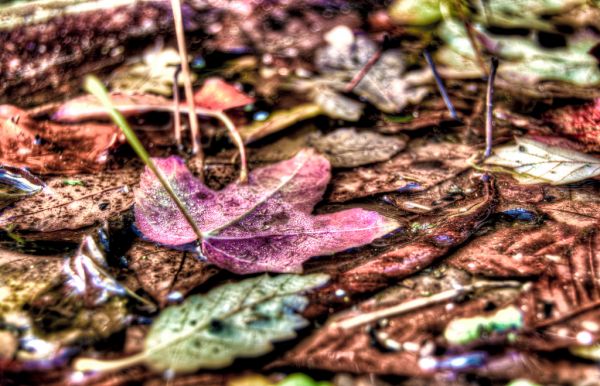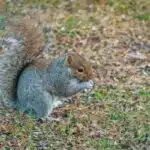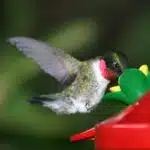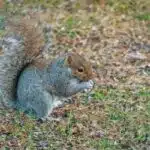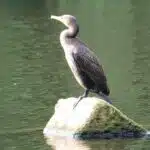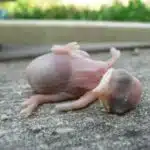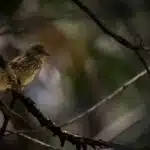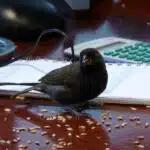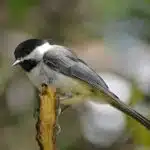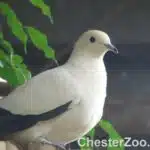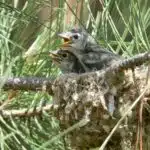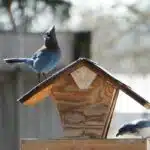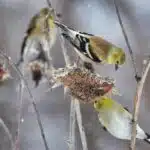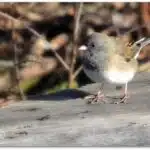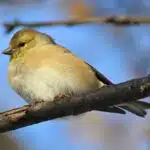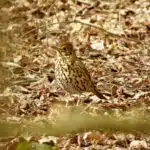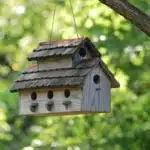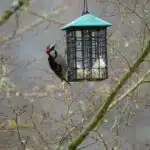A bird bath is a delightful addition to any garden or backyard. It not only provides a source of water for the birds but also adds an aesthetic appeal to the landscape. However, just like any other outdoor feature, a bird bath can quickly become dirty and unsanitary. As a bird bath care expert, it’s essential to maintain cleanliness to ensure that the birds have access to clean water and prevent the spread of diseases.
Cleaning a bird bath may seem like a simple task, but there are several factors that you need to consider. For instance, the type of material used in making the bird bath determines how you should clean it. Additionally, regular cleaning ensures that algae and bacteria don’t accumulate and cause harm to the birds or leave unsightly stains on your bird bath. In this article, we’ll provide you with expert tips on how to clean your bird bath effectively and safely.
Importance Of Regular Cleaning For Bird Baths
Regular cleaning of bird baths is crucial for maintaining a healthy environment for the birds. It also prevents the spread of diseases that can be harmful to them. As bird enthusiasts, we understand the importance of creating an inviting atmosphere for different bird species to visit and enjoy. By providing a clean and safe place for them to drink and bathe, we can attract these beautiful creatures to our backyards.
In addition to benefiting the birds, regular cleaning of bird baths has advantages for us as well. For those who enjoy bird watching, having clean water in the bath attracts more birds, which provides better opportunities for observation and photography. Besides that, it keeps the surrounding area free from dirt and debris that may lead to unpleasant odors or even attract unwanted pests like insects and rodents.
To ensure effective cleaning of your bird bath, it is important to know the different types available in the market and their specific cleaning requirements. There are various types of bird baths available ranging from simple plastic ones to elegant stone or ceramic designs. Each type presents its own unique challenges when it comes to maintenance and cleaning. By understanding these requirements, you can keep your bird bath in pristine condition all year round.
Types Of Bird Baths And Their Cleaning Requirements
- Bird baths come in a variety of materials, such as ceramic, plastic, stone, glass, and metal.
- In order to keep the bird bath clean and healthy, the water should be changed out regularly.
- Additionally, the bird bath should be scrubbed, disinfected, and have any algae removed on a regular basis.
- The frequency of changing out the water and cleaning the bird bath depends on the size and material of the bird bath, as well as the number of birds using it.
Types Of Bird Baths: Ceramic
Are you a fan of ceramic bird bath design ideas? If so, then you’ll want to know how to properly clean and maintain your beloved ceramic bird bath. Ceramic bird baths are popular because they come in a variety of designs and styles that can complement any backyard or garden. However, cleaning them can be a bit challenging.
To start, you will need to use the best ceramic bird bath cleaning products available in the market. Avoid using harsh chemicals as they may damage the glaze of your ceramic bird bath. Instead, opt for mild soaps or vinegar solutions mixed with water. Scrub gently with a soft-bristled brush to remove algae and other debris. Rinse thoroughly with clean water before refilling it.
It’s important to note that ceramic bird baths require more attention than other types of bird baths due to their porous surface. To keep them looking great, clean them regularly, every week if possible. With proper care and maintenance, your ceramic bird bath will not only provide a refreshing spot for birds but also serve as an attractive piece of decor in your outdoor space.
Plastic
As a bird bath care expert, I would like to discuss the next type of bird bath and its cleaning requirements: plastic bird baths. Plastic bird baths are known for their durability and affordability, making them a popular choice among bird enthusiasts. However, they also require proper cleaning and maintenance to ensure that birds have a clean and safe place to bathe.
To clean a plastic bird bath, start by emptying the water and removing any debris or leaves from the surface. You can use vinegar or cleaning solutions made with baking soda to disinfect the plastic surface. Scrub gently with a soft-bristled brush to remove any algae or grime buildup. Rinse thoroughly with clean water before refilling it.
It’s crucial to note that plastic bird baths can crack or become brittle over time due to prolonged exposure to sunlight. Therefore, it’s essential to keep them out of direct sunlight as much as possible and check for cracks regularly. With proper care and maintenance, your plastic bird bath will provide a refreshing spot for birds while enhancing the aesthetics of your outdoor space.
Materials Used In Bird Baths And Their Maintenance
Having discussed the types of bird baths and their cleaning requirements, it is important to note that different bird bath designs also require different materials for their maintenance. Choosing the right bird bath material can make all the difference in keeping your feathered friends happy and healthy.
Some bird bath materials, such as ceramic and glass, are fragile and prone to breakage. Others, like concrete and stone, are sturdy but can be difficult to clean due to their porous nature. Plastic bird baths are lightweight and easy to clean but may not be as aesthetically pleasing as other materials. It is important to consider your personal preferences and the needs of your avian visitors when choosing a bird bath material.
Regular cleaning of your bird bath is essential for maintaining a safe environment for birds. Necessary supplies for cleaning a bird bath include a scrub brush or sponge, mild soap or vinegar, and a hose or bucket of water for rinsing. Avoid using harsh chemicals or bleach, which can harm birds and damage the finish of your bird bath. With proper care and attention, your feathered friends will enjoy a refreshing dip in their pristine oasis year-round.
Transitioning into the subsequent section about necessary supplies for cleaning a bird bath: To ensure that you have everything you need at hand when it comes time to clean your bird bath, let’s take a closer look at the necessary supplies needed for this task.
Necessary Supplies For Cleaning A Bird Bath
- A scrub brush is a necessary tool for cleaning a bird bath and should be used to scrub the surface of the bath.
- A bucket is ideal for collecting, mixing and carrying the cleaning solution needed for cleaning the bird bath.
- Gloves should be worn when cleaning a bird bath to protect the skin from contact with the cleaning solution.
- Cloths and sponges are useful for wiping away dirt and debris from the bird bath.
- Soap and a hose can be used to rinse the bird bath after cleaning.
- For difficult to reach areas, a ladder, broom, dustpan, scrubbing pad, and a towel may be necessary.
Scrub Brush
In order to properly clean a bird bath, it is essential to have the necessary supplies. One of the most important tools for cleaning a bird bath is a scrub brush. When using a scrub brush, it is important to choose the proper type and use it correctly in order to effectively remove dirt and debris from the bird bath surface.
When selecting a scrub brush, it is best to choose one that is specifically designed for cleaning bird baths. These brushes are typically made with soft bristles that will not scratch or damage the surface of the bird bath. Some of the best brands include Songbird Essentials and Allied Precision. It is also important to consider the size and shape of the brush, ensuring that it fits comfortably in your hand and can reach all areas of the bird bath.
While a scrub brush is the ideal tool for cleaning a bird bath, there are alternatives such as sponges, cloths, and natural bristle brushes. However, these alternatives may not be as effective at removing tough stains or reaching hard-to-reach areas. When using any of these alternatives, it is important to ensure they are clean and free from any previous contaminants before using them on your bird bath. By choosing the right tool for your specific needs and using it properly, you can keep your bird bath clean and safe for our feathered friends.
Bucket
As a bird bath care expert, I highly recommend using a bucket as one of the necessary supplies for cleaning a bird bath. Using a bucket has its advantages and disadvantages when compared to other methods. One advantage is that it allows for easy transportation of water to and from the bird bath. It also provides a larger volume of water, which can be beneficial for larger bird baths. However, a disadvantage is that it may not be as effective at reaching all areas of the bird bath surface.
There are alternative methods for cleaning bird baths besides using a bucket. Some people prefer using a hose or pressure washer to clean their bird bath. While these methods can be effective at removing dirt and debris, they may also damage the surface of the bird bath if not used carefully. Additionally, they require access to an outdoor water source, which may not always be available.
Ultimately, the choice of cleaning method depends on personal preference and the specific needs of your bird bath. Regardless of which method you choose, it is important to ensure that all necessary supplies are clean and free from any previous contaminants before beginning the cleaning process. By taking proper care of your bird bath, you can provide our feathered friends with a safe and healthy place to drink and bathe.
Cleaning Solution
As a bird bath care expert, I highly recommend using a cleaning solution when cleaning your bird bath. While water alone can remove dirt and debris, it may not be enough to disinfect the surface of the bird bath. A cleaning solution can help eliminate harmful bacteria and prevent the spread of disease among birds.
There are several options for cleaning solutions when it comes to bird baths. Some people prefer to use homemade cleaners made from natural ingredients such as vinegar or lemon juice. These natural disinfectants can effectively clean and disinfect the surface of the bird bath without exposing birds to harsh chemicals. However, it is important to note that not all homemade cleaners are safe for use on all types of materials, so it is important to do research before using any new cleaning solution.
Regardless of which cleaning solution you choose, it is important to always follow the instructions carefully and avoid using too much product. Overuse of cleaning solutions can damage the surface of the bird bath and harm birds who come into contact with them. By choosing a safe and effective cleaning solution, you can ensure that your feathered friends have a clean and healthy place to drink and bathe.
Safety Measures When Cleaning A Bird Bath
As a bird bath care expert, I cannot stress enough the importance of precautionary measures and protective gear when cleaning your bird bath. Your safety should always come first before anything else. Bird baths can harbor bacteria and disease-causing organisms that are harmful to your health, so it is crucial to take necessary precautions to avoid any exposure.
Before cleaning your bird bath, make sure you have all the appropriate protective gear such as gloves, goggles, and a mask. Gloves will prevent direct contact with the contaminated water or any harmful chemicals used during cleaning. Goggles will protect your eyes from splashes of dirty water or cleaning agents that may cause irritation or injury. A face mask will filter out dust particles and other contaminants present in the air.
Cleaning a bird bath requires careful attention to detail and following a step-by-step guide for best results. However, before diving into the cleaning process, ensure that you have taken all necessary safety measures to avoid any accidents or injuries. In the next section, we will provide you with a comprehensive guide on how to clean your bird bath effectively without risking your health or damaging the environment.
Step-By-Step Guide To Cleaning A Bird Bath
Gather Supplies: It is important to have the right supplies on hand before beginning the task of cleaning a bird bath. Necessary items include a brush, cleaning solution, a scrubber, and a garden hose.
Clean the Basin: Begin by draining any standing water in the basin and scrubbing the surface with the brush and scrubber. Use the cleaning solution to remove any dirt and debris.
Rinse the Basin: Once the basin has been scrubbed, rinse with the garden hose until all residue is gone.
Refill the Basin: After the basin has been cleaned, it is ready to be refilled for birds to enjoy.
Gather Supplies
To properly clean your bird bath, you will need a few essential supplies. First and foremost, you will need a pair of gloves to protect your hands from any harmful bacteria that may be present in the water. You will also need a scrub brush, preferably one with stiff bristles that can easily remove any dirt or debris from the bottom and sides of the bird bath. Additionally, you will need a bucket for mixing cleaning solutions and collecting dirty water, as well as some bird-safe cleaner specifically formulated for use on bird baths.
When it comes to buying these supplies, there are several options available. Many home improvement stores carry all of the necessary items, including gloves, buckets, and scrub brushes. Alternatively, you can purchase these supplies online from a variety of retailers. As for the bird-safe cleaner, it is important to choose one that is gentle enough for use around birds but still effective at eliminating bacteria and other contaminants. Look for cleaners specifically labeled as safe for use on bird baths.
Properly gathering your cleaning supplies is an important first step in maintaining a healthy environment for your feathered friends. By investing in quality gloves, scrub brushes, buckets, and bird-safe cleaner from reputable sources like home improvement stores or online retailers specializing in pet care products, you can ensure that your bird bath stays clean and hygienic year-round.
Clean The Basin
Now that you have gathered all the necessary supplies, it’s time to start cleaning your bird bath. The first step is to clean the basin itself, which is the main area where birds will be bathing and drinking. Cleaning frequency is key, as stagnant water can quickly become a breeding ground for harmful bacteria and algae.
To start, empty out any remaining water from the basin and use a scrub brush to remove any debris or dirt that may have accumulated. It’s important to use best practices for scrubbing, such as starting at the top of the basin and working your way down in a circular motion. This will help ensure that all areas are thoroughly cleaned.
Once you have scrubbed the entire basin, rinse it out with clean water until no soap residue remains. You can then fill it back up with fresh water for your feathered friends to enjoy. By following these simple steps and regularly cleaning your bird bath, you can provide a safe and healthy environment for birds to visit throughout the year.
Removing Stains And Mineral Deposits From A Bird Bath
After successfully cleaning out your bird bath, it’s important to keep it maintained and looking its best. One common issue that bird bath owners encounter is hard water stains and mineral deposits building up over time. These unsightly stains not only ruin the aesthetic of the bird bath, but they can also have negative effects on the birds that use it.
Fortunately, there are natural cleaning solutions available that can effectively remove hard water stains from a bird bath without harming the environment or the birds themselves. One option is to mix equal parts vinegar and water in a spray bottle and apply it directly to the stained areas. Let it sit for 10-15 minutes before scrubbing with a soft-bristled brush and rinsing thoroughly with clean water.
Another natural solution is to use baking soda mixed with a small amount of water to create a paste. Apply this paste directly onto the stains and let it sit for 20-30 minutes before scrubbing with a brush and rinsing clean. These methods are effective at removing hard water stains while being gentle on the materials of your bird bath.
- Mix equal parts vinegar and water in a spray bottle.
- Apply vinegar mixture to stained areas.
- Scrub with soft-bristled brush.
- Rinse thoroughly with clean water.
Removing hard water stains doesn’t have to be difficult or harmful to the environment. By using natural cleaning solutions, you can keep your bird bath looking beautiful while ensuring that your feathered friends stay healthy and happy.
As important as cleaning is for maintaining your bird bath, preventing algae and bacterial growth is equally crucial for keeping it in top condition. In the next section, we’ll explore some proactive measures you can take to prevent these issues from arising in the first place.
Preventing Algae And Bacterial Growth In A Bird Bath
As a bird bath care expert, I know that preventing algae and bacterial growth in your bird bath is crucial. Not only can these microorganisms harm the birds that use it, but they can also make the water look unsightly and emit unpleasant odors. To prevent these issues, consider adding a few drops of vinegar or hydrogen peroxide to the water each time you refill it. This will help keep the water clean and fresh for longer periods of time.
Another way to prevent algae growth is by providing shade for your bird bath. Algae thrives in sunlight, so placing your bird bath in a shaded area can help reduce its growth. Additionally, adding a fountain to your bird bath can also help prevent algae and bacterial growth. The movement of the water creates oxygenation, which discourages the growth of these microorganisms. Not only does this benefit the health of your feathered friends, but it also makes for a more visually appealing bird bath.
Preventing mosquito infestation is another important consideration when caring for your bird bath. Mosquitoes are attracted to stagnant water, making bird baths prime breeding grounds for them. To prevent this issue, consider changing out the water in your bird bath every two to three days during mosquito season or adding a mosquito dunk to the water. These dunks release bacteria that target mosquito larvae and prevent them from maturing into adult mosquitoes.
To maintain a healthy environment for birds and other wildlife in your backyard, preventing algae and bacterial growth in your bird bath is essential. Adding vinegar or hydrogen peroxide, providing shade, adding a fountain and preventing mosquito infestation are all effective ways to keep your bird bath clean and safe for use by our feathered friends. In order to ensure optimal health benefits for birds using it as well as aesthetic appeal, it’s important to clean regularly as well – which we’ll discuss next!
How Often To Clean A Bird Bath
Maintaining a clean and fresh bird bath is crucial to ensure the health and safety of your feathered friends. But how often should you clean it? The answer varies depending on factors such as the weather, location, and usage. Generally, it is recommended to clean your bird bath at least once a week during warmer months when birds tend to visit more frequently.
During hot summer months, algae and bacteria can grow rapidly in stagnant water, making it essential to clean your bird bath more frequently. On the other hand, during colder months or when there is less bird activity, you may be able to get away with cleaning it every two weeks. However, always keep an eye on the water quality and cleanliness of the bath to determine if it needs more frequent cleaning.
The best time to clean a bird bath is early in the morning before birds start their day. This way, you won’t disrupt their routine, and they can enjoy a clean bath throughout the day. Make sure to use mild soap or vinegar and rinse thoroughly with clean water before refilling it with fresh water. By following these guidelines for how often to clean your bird bath and choosing the best time for cleaning, you can ensure that your feathered friends have access to safe and healthy bathing water year-round.
Transition: Now that you know how often to clean your bird bath and when’s the best time to do it let’s move on to another important aspect of taking care of your feathered visitors – winterizing your bird bath.
Winterizing Your Bird Bath
As the winter season approaches, it’s important to consider how to protect your bird bath from the harsh weather conditions. Not only will this keep your feathered friends safe and comfortable, but it will also extend the lifespan of your bird bath. There are various insulating options you can choose from to winterize your bird bath.
Firstly, you can purchase an insulated bird bath cover. This is a simple and effective way to protect your bird bath from frost and snow, while also helping to retain heat. These covers come in different sizes and shapes, so make sure you measure your bird bath before purchasing one.
Another option is to add a heater to your bird bath. This will not only keep the water from freezing over, but it will also provide warmth for birds during colder months. Make sure to use a heater that is specifically designed for bird baths and follow the manufacturer’s instructions carefully. Weather protection is crucial when it comes to keeping your bird bath in good condition during winter months.
Overall, there are various ways you can winterize your bird bath and protect it from damage caused by cold weather conditions. Insulated covers and heaters are just two examples of insulating options you can use to help keep birds happy and healthy during colder months. In the next section, we’ll discuss tips for maintaining your bird bath throughout the year.
Tips For Maintaining A Bird Bath
Maintaining a bird bath is crucial to keep it clean and safe for birds. While regular cleaning is necessary, there are also some tips that can help you maintain your bird bath in good condition. Here are a few essential tips for keeping your bird bath healthy:
Firstly, always remember to refill the bird bath with fresh water regularly. Birds prefer clean water, and stagnant water can attract mosquitoes and other insects that may harm the birds. You can also consider installing a fountain or dripper to add motion to the water, which will help prevent stagnant water.
Secondly, monitor the area around the bird bath for any debris or droppings. If any leaves or twigs fall into the bird bath, remove them immediately as they can cause blockages in the drainage holes of your bird bath. Additionally, if you notice any algae growth or discoloration on your bird bath’s surface, it’s time for a cleaning.
Lastly, consider investing in a DIY bird bath instead of buying one from stores. Not only does this save money and reduce waste, but it also allows you to customize your bird bath based on your preferences. You can use materials such as terracotta pots or stones to create an attractive and personalized design that will attract birds to your backyard.
Table:
| Tips for Maintaining a Bird Bath | | — | — | | Refill with fresh water regularly | | Remove debris immediately | | Consider DIY options |
In summary, maintaining a clean and healthy environment for birds is critical when it comes to attracting them to your yard. Following these simple tips will help ensure that your bird bath remains an inviting oasis for feathered friends throughout the seasons. Next up: let’s explore some common mistakes people make when cleaning their bird baths so that you can avoid them!
Common Mistakes To Avoid When Cleaning A Bird Bath
1.One of the most common mistakes bird bath owners make is not cleaning the bird bath frequently enough. 2. Microorganisms, such as algae and bacteria, can quickly build up and make the bird bath unhealthy for birds. 3. Another mistake to avoid is using harsh chemicals to clean the bird bath, as these can be toxic for birds and other wildlife. 4. Instead, bird bath owners should use mild soaps, such as a dishwashing soap, and rinse the bird bath thoroughly to ensure no residual chemicals remain.
Not Cleaning Frequently Enough
Failing to clean your birdbath regularly is a common mistake among bird enthusiasts, and it can have negative effects on the health of the birds that visit your yard. It’s important to keep in mind that stagnant water can quickly become a breeding ground for harmful bacteria and parasites that can threaten the well-being of your feathered friends. As an expert in bird bath care, I highly recommend cleaning your bird bath at least once a week during the warm months and every other week during cooler weather.
Proper placement of your bird bath is also crucial when it comes to maintaining its cleanliness. Placing it in direct sunlight, away from trees or bushes, will help prevent debris such as leaves and twigs from falling into the water. Additionally, adding a fountain or bubbler to your bird bath can provide multiple benefits. Not only does it create movement in the water which deters mosquitoes and other insects from laying eggs, but it also helps circulate fresh water throughout the bowl, reducing the likelihood of bacterial growth.
In conclusion, neglecting to clean your bird bath on a regular basis is one of the most common mistakes made by backyard bird enthusiasts. The consequences of this mistake can be dire for both birds and humans alike. By keeping your birdbath clean and properly placed with added features like fountains or bubblers, you are providing a safe haven for our feathered friends while also creating an enjoyable environment for yourself. Remember that we should always strive to serve others, even if those others happen to have wings!
Using Harsh Chemicals
As a bird bath care expert, it is important to address the issue of using harsh chemicals when cleaning your bird bath. While it may seem like an easy solution to remove dirt and grime, these chemicals can have harmful effects on both birds and the environment. Instead, consider alternative cleaning methods that are more natural and gentle.
One option is to use natural cleaning solutions such as vinegar or baking soda mixed with water. These solutions can effectively clean your bird bath without leaving behind any toxic residue. Another option is to use a power washer with a low pressure setting to blast away debris without harming the surface of your birdbath.
By avoiding harsh chemicals and opting for more natural cleaning solutions, you are not only protecting the health of birds but also doing your part in preserving the environment. Remember that our feathered friends rely on us for their safe haven, so let’s make sure we are providing them with a clean and healthy habitat.
Eco-Friendly Cleaning Solutions For Bird Baths
The bird bath is an essential element for the survival and well-being of our feathered friends. However, it requires regular maintenance to function optimally. Eco-friendly cleaning solutions are a great way to keep your bird bath clean while preserving the environment. These cleaning solutions are easy to make and use ingredients that are readily available at home.
DIY bird bath cleaners can be made using natural ingredients such as vinegar, baking soda, lemon juice, and hydrogen peroxide. White vinegar is an excellent option for removing mineral deposits and stains from the surface of your bird bath. Baking soda mixed with water can be used to scrub away dirt and grime from the surface of your bird bath. Lemon juice mixed with water is also an effective cleaning solution for bird baths.
Eco-friendly cleaning solutions not only keep your bird bath clean but also minimize the risk of contamination by harmful chemicals. In addition, they are cost-effective and easy to prepare. By using these DIY cleaners, you will not only save money but also contribute to protecting the environment. In the next section, we will discuss some troubleshooting tips for maintaining your bird bath in good condition.
Troubleshooting Tips For Bird Bath Maintenance
As a bird bath care expert, it is important to understand that regular cleaning is essential for the health and safety of birds. However, even with the best intentions, common issues can arise during bird bath maintenance. Troubleshooting techniques can help address these issues and ensure your feathered friends have a clean and safe place to drink and bathe.
One common issue with bird baths is algae growth. Algae can make the water look green or slimy and can be harmful to birds if left unchecked. To combat this issue, consider adding a small amount of white vinegar or hydrogen peroxide to the water when you refill it. You can also scrub the sides of the bird bath with a solution of warm water and vinegar or use an algae inhibitor product.
Another issue that may arise is debris accumulation in the bird bath. Leaves, twigs, and other outdoor debris can fall into the water, making it dirty and uninviting for birds. To avoid this problem, try placing the bird bath in an area sheltered from trees or other sources of debris. You should also regularly empty and clean out any accumulated debris from the basin.
Birds are beautiful creatures that bring joy to many people’s lives, but they require certain care to thrive in our human-made environments. Troubleshooting common issues such as algae growth or debris accumulation in your bird bath will help ensure that your backyard visitors have a safe and clean place to drink and bathe. By taking these simple steps, you can create a welcoming environment for all types of birds in your community.
3 Emotional Items:
- Birds rely on humans for their survival in urban areas.
- Providing a clean bird bath allows birds to stay healthy.
- By maintaining a birdbath properly, you are supporting biodiversity in your community.
Transition: While many common issues with bird baths can be resolved through proper cleaning techniques, some concerns may require more specific solutions. In the next section, we will answer frequently asked questions about bird bath cleaning to help you troubleshoot any issues that may arise.
Frequently Asked Questions About Bird Bath Cleaning
If you’re a bird lover, then having a bird bath in your garden can be an excellent way to attract feathered friends. However, maintaining the bird bath’s cleanliness is crucial for keeping the birds healthy and visiting your garden. Bird baths should be cleaned regularly to prevent the growth of algae, bacteria, and other harmful microorganisms that could harm birds’ health.
Cleaning frequency is essential when it comes to bird bath maintenance. In general, it is recommended that you clean your bird bath at least once a week during warm weather when algae growth is prevalent. During colder months, cleaning once every two weeks may suffice. However, if your bird bath is in direct sunlight or heavily shaded areas where debris accumulates quickly, you may need to clean more frequently.
When it comes to cleaning products for bird baths, there are several options available. Some experts recommend using mild dish soap with water for cleaning purposes as it effectively removes dirt and grime without harming birds. Others suggest using vinegar or bleach solutions for tough stains or heavy algae buildup. It’s worth mentioning that harsh chemicals such as bleach should never be used in large amounts as they can damage the birdbath’s surface and harm birds’ eyes and respiratory systems.
Overall, ensuring your bird bath remains clean and hygienic helps keep our feathered friends healthy while attracting new ones to your garden. By following the recommended cleaning frequency and using mild cleaning products such as dish soap or vinegar solutions, you can maintain a beautiful birdbath in your backyard all year round!
Conclusion
In conclusion, proper maintenance of a bird bath is essential for the well-being of our feathered friends. Neglecting to clean or maintain a bird bath can lead to algae growth, bacteria build-up, and ultimately harm the birds that rely on it for hydration and hygiene. As experts in bird bath care, we understand the importance of using eco-friendly cleaning solutions and avoiding common mistakes such as using harsh chemicals or abrasive materials.
Symbolically speaking, a bird bath represents not only a source of water but also serves as a sanctuary for birds to rest and rejuvenate. By taking the necessary steps to clean and maintain your bird bath, you are providing a safe haven for these delicate creatures in an otherwise chaotic world. Let us all do our part in preserving this symbol of peace and harmony by ensuring that our bird baths are clean and well-maintained at all times.
Image Credits
- “bird bath” by Jon Bunting (featured)

